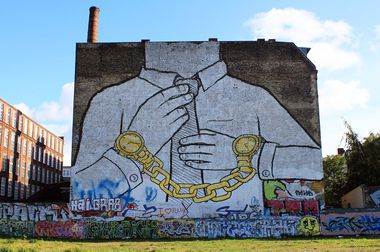Baukasten:English:A Short Story About Time
A Short Story about Time
With the help of a picture book based on Charles Dickens' Christmas story, the topic of working hours in today's society is studied. At first, the historical development of the problem during industrialization is presented. The topic of time in today's society will follow. Here, the period of time is defined with its various sub-aspects and the concept of 'work' is discussed. Finally, some solutions are presented.
Preparation
Preparation for the moderators
Reading of the story and additional information on time.
Preparation for the participants
No preparation required.
Material and room
Picture Book, Beamer, maybe Audio Player with speakers
Schedule
Room preparation
A reading table, a beamer and a laptop with the attached presentation BE_Semesterpräsentation_Zeitwohlstand.pdf is needed. In addition, the printed version of the story can be distributed to the participants during the presentation.The table is facing a white wall where the images of the picture book are projected. The chairs are placed in a semicircle around the table. Next to the table, a lamp can be added to create a better atmosphere. All other lights should be turned off.
Minute 00.- Welcome and announcements
The moderator welcomes the participants, makes the weekly organizational announcements and presents the agenda of the seminar.
Minute 05. - Reading chapter 1 (up to page10)
In addition to the reader, another person is needed, who according to the picture book template BE_Zeitwohlstand_Bilderbuch.pdf, projects the appropriate picture for the respective part of the story. BE_Semesterpräsentation_Zeitwohlstand.pdf
After a short introduction (reader, topic, agenda of the building block), the reader can begin. S/He should read carefully, slowly and with different tones. After the first chapter is read, the reader initiates a small discussion. The focus is on two main areas: content-related questions and / or personal questions. The final discussion should last longer and cover both topics.
Minute 20. - Questions and discussion
Sample questions for chapter 1 (up to page 10 of BE_Zeitwohlstand_Bilderbuch.pdf)
- What do you think of a collective day of leisure? Do you advocate a day-off on Sunday?
- Is it necessary, for example, to go shopping on Sundays? Why?
Minute 30.- Reading Chapter 2 (up to page 26)
Please follow the same instructions as for chapter 1.
Minute 45. - Questions and discussion
Sample questions for Chapter 2 (up to and including page 26)
- What four points define the time wealth? Give a brief explanation of the points.
(Here, four different people can participate) Answer: quantitative time ownership, self-determination, adequate work density, collective rest.
- What does the classical concept of 'work' mean? What activities are devalued in today’s world?
Answer: 'work' = employment, depreciation of reproductive work, social work, political work, etc.
Minute 55. - Reading Chapter 3 (until the end of the story)
Please follow the same instructions as for chapter 1.
Minute 70. Final discussion
Sample questions for chapter 3 / Final discussion 1. Do you have enough time? Opinion: Do you feel like you have enough time? Do you think it will be different in the future? (That after you study, time pressure rises) 2. Do you find the problems mentioned exaggerated? 3. What solutions do you have for the problems of today's society?
Hints and notes.
From the authors.
Ideas for further development of the building block
The picture book could be used as an audiobook. Each speaker is assigned one character from the book. However, one speaker can use different voices to present multiple characters.
A microphone and audio editing software are required for recording. A free open source software is e.g. Audacity (audacity.sourceforge.net). As additional "features", a background music and some sounds can also be played for certain events (e.g., a particular sound when traveling with a ghost). In addition, distorted voices would be conceivable (e.g., an old voice for Alfred or a mechanical voice for the robot). Speakers are required for the seminar. If the picture book is presented in an exhibition style, you can equip several mobile devices with headphones and read out the picture book so that people can listen to the story.
Abbreviated variant.
The story is based on Charles Dickens' Christmas story. It is possible to limit this creative part and focus on the concept of time. Some conceptions of time (e.g., "The 4-in-1-Perspective" by Frigga Haug) didn’t fit into the picture book format or were roughly presented. Therefore, this could be further developed in the future. (See BE_WissText_Zeitwohlstand.pdf)
Materials for implementation.
- BE_AShortStoryaboutTime_BuildingBlock.pdf
- BE_AShortStoryaboutTime.pdf
Literature and references
- J.P. Rinderspacher, Zeitwohlstand, Wachstum und Umwelt, Contribution to the discussion forum Ecological-Social Market Economy October 2012 (http://www.gbw.at/fileadmin/user_upload/gbw_allgemein/Rinderspacher-Zeitwohlstand-Wachstum-Umwelt.pdf, Access November 2013)
- F. Haug, The Four-in-One Perspective as a Guide to Policy, In. THE ARGUMENT Issue 2/2011
- U. Mückenberger, Zeitwohlstand - a current debate and its roots; The concept of Bob Goodin and his temporal political implications (http://www.zeitpolitik.de/pdfs/VortragMueckenberger.pdf, access November 2013)
- M. Garhammer, working hours and time stability in international comparison - a key question for the quality of life in Europe, Bamberger contributions to European research and international policy No. 5/2000
- Www. Timwohlstand.info (access November 2013)
- J.P. Rinderspacher, Zeitwohlstand in der Moderne, publication series of the cross-section Working & Ecology at the President of the Wissenschaftszentrum Berlin for Social Research, 2000 (http://www.econstor.eu/bitstream/10419/50297/1/311840884.pdf, access January 2014)

